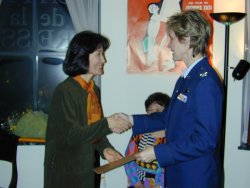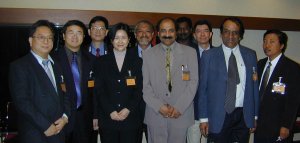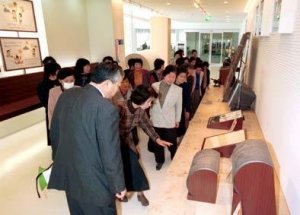Story of this month>>>>
Japan's Media Industry Opposes Three Bills
Expected to Tighten Regulation of the Media
|
|
The media industry in Japan is in a crisis over the proposed Human Rights Protection Law, the planned Personal Information Protection Law and the so-called Basic Law on Social Environment for Young People.
These three proposed laws might superficially appear to reflect good intentions, but they contain elements that could infringe upon the freedom of expression guaranteed by Article 21 of the Constitution. The proposed laws would allow a public authority to define and interpret what type and scope of personal information, human rights violations and harmful information would be subject to regulation. At risk are freedom of expression by the general public and the freedom of the media to gather and report the news.
The Japan Newspaper Publishers and Editors Association (NSK=Nihon Shinbun Kyokai), the National Association of Commercial Broadcasters in Japan (NAB) and NHK have repeatedly voiced opposition to these bills. The three organizations have launched protest campaigns including the organization of a symposium, while paying heed to developments in the debate at the National Diet since the passage of the budget.
Media organizations are also raising the issue in newspaper pages and in TV programs to inform readers and viewers of the freedoms at stake, calling for a wholesale review of the proposed bills.
The personal information protection bill was submitted to the ordinary session of the Diet in March 2001, and has been carried over to the current Diet. That proposed legislation sets five basic principles as criteria for personal information that allows identification of particular individuals, setting restrictions on the purposes of utilizing personal information, appropriateness of its acquisition, its accuracy, and the safety and transparency of its use.
These principles are made to apply to the gathering and reporting of news. Although the media such as newspapers, news agencies and broadcasting networks are to be generally exempted from obligatory regulations such as rules on disclosure and public scrutiny imposed on providers of personal data, it is left entirely to the discretion of an administrative authority to define what controls should apply to news reporting.
Prior to the government's submission of the bill to the Diet, NSK, NAB and NHK presented their respective written opinions to the government, seeking the complete exemption of the media from the terms of the proposed law. The Japan Magazine Publishers Association, the Japan Book Publishers Association, writers' groups, attorneys, freelance writers and four opposition parties are also opposing the proposed laws, out of fears that they would lead to restrictions of not only media activities, but also of freedom of expression by the general public. On April 5, NSK, NAB and NHK jointly organized a symposium to oppose the proposed legislation.
The human rights protection bill was submitted to the current Diet on March 8. The Justice Ministry Council for Human Rights Protection drafted an interim report in November 2000, proposing the creation of a powerful independent body to help victims of human rights violations.
The panel proposed relief for 1) discrimination; 2) abuses; 3) human rights infringements by public authorities and 4) rights violations by the media. In May 2001, the panel issued a final report that incorporated the idea of providing relief for victims of the so-called "media scrum" or excessively aggressive collective reporting.
NSK said in January and again in June 2001, that it deplored the fact that the proposed law would put human rights violations by the media on a par with abuses and discrimination. In its released written opinions, NSK called for due consideration to be paid to the freedom of reporting, saying that media violations should be rectified through voluntary efforts by the media (see related article in the February issue of the NSK News Bulletin).
However, the proposed bill designates violations of privacy involving victims of criminal offenses and excessively aggressive reporting as matters for "special relief", instead of "general relief," which would lead to forcible measures such as disclosure requirements and warnings.
Moreover, repeated and persistent efforts to contact and elicit responses from news sources via telephone and facsimile for newsgathering is defined as an act that falls in the category of "excessive reporting" eligible for special relief under the proposed law. The bill stipulates that the proposed human rights watchdog is to be able to warn the media to halt newsgathering in order to stop human rights infringements, and in the event of noncompliance by the media, the commission is to be able to publicize the details of its warning. Media organizations are not to be given any chance to file complaints against decisions of the watchdog body.
Another problem is that the secretariat of the proposed third-party body is to be staffed by officials from the Justice Ministry Civil Liberties Bureau, while the work of the commission's regional offices is to be entrusted to the ministry's district legal affairs offices, casting doubt on the independence of the proposed body.
On March 7, NSK, NAB and NHK issued a joint statement saying that the proposed bill would invite unnecessary intervention in news reporting. The statement restated earlier-expressed fears that "enthusiastic newsgathering activities" and "persistent reporting" in the aim of honoring the public's right to know would be hindered and said that as a result, the proposed bill is intolerable.
The three organizations also jointly organized on March 25 a symposium entitled "On the Proposed Human Rights Protection Law Statutory Regulation and Self-Discipline of the Media."
There have been moves within the ruling Liberal Democratic Party to submit the so-called Basic Law on Social Environment for Young People to the Diet in the form of member's legislation. That planned bill would make all forms of expression subject to regulation and would obligate each industry to set up a body for voluntary restraint. While its definition of "harmful" information is obscure, the bill would allow interference with the media in the form of advisories or warnings issued by the respective Cabinet minister in charge or by prefectural governors.
Again, these three bills contain elements that would allow public authorities to intervene in various forms of expression under the pretext of protecting privacy, human rights and youth, while leaving obscure the distinction between fair reporting and harmful information and the distinction between private and public figures.
All these moves are taking place against a backdrop of growing distrust in the media by readers and viewers that has resulted from excessively aggressive or intrusive reporting and violations of privacy and human rights by the media. One way or another, the government and administrative authorities appear determined to capitalize on the prevailing public sentiment against the media in order to tighten the regulation of the media.
On the controversial issue of the so-called "collective media scrum," NSK has been addressing the issue of imposing remedial measures. Toward the end of 2001, for instance, NSK issued a guideline against collective aggressive newsgathering to apply to all news reporters and photographers (see related article in the January issue of NSK News Bulletin).
In March of this year, NSK set up a sub-committee charged with finding solutions to any problems or damage that cannot be solved on-site under that guideline. NSK has agreed to act in close collaboration with the broadcasting industry on this score. The sub-committee is made up of representatives of 15 NSK member companies: Asahi Tokyo, Mainichi Tokyo, Yomiuri, Nikkei, Sankei Tokyo, Hokkaido, Chunichi Tokyo, Nishi-Nihon and four other regional newspapers, along with Kyodo News, Jiji Press and NHK.
An increasing number of newspaper companies are also setting up third-party ombudsman committees made up of outsiders to scrutinize news reporting. Including the Minami-Nihon Shimbun and the Kumamoto Nichi-Nichi Shimbun, which set up such committees on April 1, the total number of newspaper companies with ombudsman committees now totals 25 (see related article in the February issue of the NSK News Bulletin).
|
|
TV Interviews Accepted as Evidence
The Wakayama District Court on March 22 agreed to a prosecution request to use as evidence video footage of TV interviews with the woman accused in the 1998 mass curry-poisoning case. There have been cases in which videotapes recording scenes of crimes have been adopted as evidence, but it is unusual for a court to accept video footage from TV interviews. Six private broadcasters issued a joint statement in protest against the court decision.
The court agreed to accept as an affidavit two videotapes that contain 20 minutes of footage edited by Wakayama Prefectural Police from recordings of eight TV programs. The programs on the incident were aired by four private broadcasters between Oct. 4, 1998, when defendant Masumi Hayashi was arrested, and May 13, 1999, when the first hearing was held in her trial.
In the much-publicized case, Masumi Hayashi, 40, a former insurance saleswoman, stands accused of killing four people and making 63 others ill by serving curry laced with arsenic at a summer community festival in Sonobe, Wakayama Prefecture, on July 25, 1998. Masumi and her husband Kenji were arrested and later indicted in October 1999 on several counts including murder, attempted murder and insurance fraud.
Alarmed by the court decision, Asahi Broadcasting, Mainichi Broadcasting, Kansai Television, Yomiuri Television, TV Osaka and TV Wakayama issued a joint statement on March 22. In the statement, the broadcasters said that the adoption of taped TV broadcasts as evidence means that parts of news programs are to be used for purposes other than reporting, leading the public to lose confidence in the function of news reporting. The statement described the court decision as "truly regrettable," saying that it amounts to the imposition of restrictions on the people's right to know and the freedom of conducting news reporting.
The ruling of Presiding Judge Ikuo Ogawa of the Wakayama District Court contained three main points. First, he found that the freedom of reporting and gathering news can be hindered in order to ensure proper criminal trial proceedings. Second, he ruled that the acceptance into evidence of previously broadcast TV programs in a trial of a criminal case does not amount to an infringement of the freedom of reporting. And third, he said that police investigators had not deceptively edited the videos in question. The two videos containing the eight programs were later played in the courtroom for examination.
Since the woman defendant has remained totally silent since her arrest, Wakayama district prosecutors submitted the recorded TV programs for acceptance as evidence in December 2000. The six private broadcasters and NHK's Osaka office submitted a letter to the prosecutors, seeking the withdrawal of their request for the acceptance of the videos as evidence. A similar letter was submitted to the Wakayama District Court, seeking the exclusion of the video footage.
Newspark Photo Exhibition Features 2 Pulitzer-Winners
A photo exhibition featuring the works of Kyoichi Sawa da and Toshio Sakai, who both won Pulitzer Prizes for their outstanding photography during the Vietnam War, opened on March 26 at the Japan Newspaper Museum, known as Newspark, in Yokohama. da and Toshio Sakai, who both won Pulitzer Prizes for their outstanding photography during the Vietnam War, opened on March 26 at the Japan Newspaper Museum, known as Newspark, in Yokohama.
An opening ceremony was held in the evening of the first day of the show with the attendance of the widows of the two photojournalists, Sata Sawada and Hideko Sakai. Col. Beverly L. Lee, a public relations officer for the United States Forces, Japan, returned the press pass issued by the U.S. military for Sakai to his widow (photo below). The press pass had been kept in the custody of the U.S. forces.
Sata Sawada said that her husband had always been saying he wished for the return of a peaceful world. Hideko Sakai said she remembered her husband telling her that war deprives men of freedom and dignity and nothing good is born out of it. "He desired to see a world in which no reporters would have to cover stories of refugees and wars," she said.
The exhibition features Sawada's "Flee to Safety," which won him the Pulitzer Prize in 1966, and Sakai's "Dreams of Better Times," which brought him the prestigious prize in 1968. Both Sawada and Sakai worked for United Press International (UPI). Also on display are about 120 photos by the two men that vividly depict the harsh reality of the war and the battlefields, the cameras that the photographers used, their note pads and the certifications of their Pulitzer Prizes. the cameras that the photographers used, their note pads and the certifications of their Pulitzer Prizes.
Sawada and Sakai were two of only three Japanese photojournalists ever to win the Pulitzer Prize. Sawada was fatally shot in Cambodia in 1970. He was 34. Sakai died due to an illness in 1999 at the age of 59.
The photo exhibition, organized jointly with the Kanagawa Shimbun and Kyodo News, will run through May 19.
International Seminar Focuses on Media Ethics
NSK hosted a seven-day international seminar on media ethics starting from March 27 for 10 newspaper editors from Asian countries. The symposium, titled, Media Ethics: In Pursuit of Reliable Journalism 2002, was organized as part of NSK's Asia Program aimed at promoting the development of the newspaper and news-reporting industries in Asia. The foreign participants came from China, Hong Kong, India, Indonesia, Malaysia, the Philippines and Thailand.
Honorary Professor Akira Aoki of Tsukuba University opened the seminar with a keynote speech on the theme of the various ethical problems facing Japan's newspaper industry. Senior editors and editors-in-chief of the Mainichi Shimbun, the Yomiuri Shimbun, Kyodo News and the Tokyo Shimbun also made presentations on the main subject. The participants visited the press club at the Prime Minister's Official Residence and the head office of the Nihon Keizai Shimbun to discuss newspaper-related problems and tasks common to Japan and the countries of the foreign participants.
NSK launched its Asia Program in 1993, in the aim of contributing to the development of the newspaper industries in the Asian region in response to their expressed desire to learn from Japanese experiences and technologies to nurture their news reporting. The seminar is held regularly in Japan for invited senior officials of newspaper companies, news agencies and broadcasters from elsewhere in Asia.
 |
The participants in this year's program were, from the left,
Dr. Camoes Tam Chi-keung(Hong Kong),
Mr. Chen Ping(China),
Mr. Chan Chak-chiu(Hong Kong),
Ms. Xu Jing(China),
Mr. Thongtham Nartjamnong(Thailand),
Mr. Sunil Dang(India),
Mr. R. Mathivanan(Malaysia),
Mr. Dionisio L. Pelayo(Philippines),
Mr. Shravan Kumar Garg(India),
Mr. Djoko Pitono Hadiputro(Indonesia).
|
|
|
Topics.......Topics.......Topics........
|
Fukui Shimbun Opens Newspaper Pavilion in New Building
The Fukui Shimbun on March 1 opened a Newspaper Amusement Pavilion on the second floor of its new company office as part of its services for readers.
The 340-square-meter pavilion depicts the origins of characters and paper, the history of newspaper articles and advertisements, the transition of newspaper production equipment and other subjects.s Together with an exchange zone on the first floor that houses a gallery, a caf£Ś and a multi-purpose hall, readers and the general public are invited to make free use of the new facility.

On display at a corner titled "A Century of Newspaper-Making" are the newspaper's first issue, from 1899, and the actual newspaper pages that covered major domestic and international news, such as the U.S. Apollo 11 moon landing, the Tokyo Olympic Games and the Fukui Major Earthquake. Also on display are copies of newspaper advertisements that represent past times, cameras that were used over the years for news reporting, manuscript papers and word-processors that were used by reporters.
|
The Fukui Shimbun is based in Fukui City, Fukui Prefecture, where it publishes 30-34 pages daily morning newspaper with a circulation of about 200,000.
|
Asahi Launches Media Course At Sophia University
The Asahi Shimbun on April 10 opened a special course on the "current state of journalism" in collaboration with Sophia University's Department of Journalism.
In the first semester for 2002, veteran Asahi reporters and editors are giving lectures in rotation on the theme of "politics and media." The lecturers will include Shin'ichi Yoshida, chief of the planning and reporting office, Tadakazu Kimura, an editorial writer, Toru Hayano, an editorial board member, and Hiroshi Hoshi, another editorial board member. They will speak about newsgathering at the Prime Minister's Official Residence and on political parties, as well as discussing the media's role during elections.
Professor Hiroshi Fujita, who is coordinating the collaboration with Asahi, said that the special course would work as a bridge to bring university study of journalism closer to the forefront of the media. He said he expected the new course to help to expand the scope of research at the Department of Journalism. Akio Nomura, managing director of Asahi's Comprehensive Research Center, said that the lecturers are focused on delivering substantial lectures that won't end up as mere recitals of personal experiences or hard-luck stories.
In the second semester, Asahi reporters from the economic news, city news and lifestyle divisions will lecture about how to collect information, gather news and write articles. Asahi also opened a similar course at Hosei University in April.
The Yomiuri Shimbun is due to start a course at International University's Health and Welfare Graduate School in September, and the Hokkaido Shimbun will follow suit at the Graduate School of Hokkaido University.
Over the past three to four years, newspaper companies have increasingly been making donations to universities in order to set up and manage courses in cooperation with school authorities. These undertakings are aimed at helping students to deepen their understanding of the role of newspapers.
NHK Opens Course for University Students in Kyoto
In commemoration of its 70th anniversary, NHK's Kyoto broadcasting station has set up a special lecture course for university students in Kyoto that will start in April and run into July. The project is the first of its kind and is aimed at having students become more familiar with NHK.
The course will feature a series of 13 lectures given at Campus Plaza Kyoto, located in front of the JR Kyoto Station. Entitled "The Forefront of TV Media: The Current Status and The Social Role," NHK President Katsuji Ebisawa and NHK producers and newscasters will lecture about their activities.
The course is being operated by Ritsumeikan University's College of Social Sciences and is counted as an official credit by all 50 member universities and colleges of the University Consortium Kyoto.
The University Consortium Kyoto was established in March 1998 in the aim of meeting the needs of students and the society in university education. The organization promotes a common credit scheme among universities and city colleges.
Kanagawa Shimbun Starts Online Evening Edition
The Kanagawa Shimbun, a morning paper publisher, started posting an evening edition called, "YOKOHAMA You Can," on its Web site on March 20. It also began posting a special corner featuring community information from the daily newspaper's regional editions.
The new projects are aimed at attracting long-term subscriptions to the morning paper. After a trial period of free access, users of the new Web services will be charged a fee, starting in mid-May. But those who subscribe to the morning daily paper will continue to enjoy free access to the online evening edition.
With the catch phrase of "Get The Evening News A Little Ahead of Others," the online evening edition delivers about 30 news items at 2 p.m. every day, except Sundays, national holidays and press holidays. It covers news events from midnight on the previous day through noon. The contents of the online evening edition stay up only for that day. News is selected from wire articles distributed by Kyodo News and articles prepared and edited by the Media Division. In the community information corner, all of the day's items from the daily's seven regional editions are made available in PDF form.
Yuichi Matsuzawa, managing director of the Kanagawa Shimbun's Media Division, said "eye-catching entertainment contents will also be posted so that it will be possible to charge a fee for those who use only the new services."
|
The Kanagawa Shimbun is based in Yokohama City, Kanagawa Prefecture, where it publishes 22-28 pages daily morning newspaper with a circulation of about 240,000.
|
|
|
Nihon Shinbun Kyokai
The Japan Newspaper Publishers & Editors Association
Nippon Press Center Bldg., 2-2-1 Uchisaiwai-cho, Chiyoda-ku,
Tokyo100-8543, Japan
bulletin@pressnet.or.jp.
Copyright 2002 Nihon Shinbun Kyokai
All right reserved
|
|
|
 da and Toshio Sakai, who both won Pulitzer Prizes for their outstanding photography during the Vietnam War, opened on March 26 at the Japan Newspaper Museum, known as Newspark, in Yokohama.
da and Toshio Sakai, who both won Pulitzer Prizes for their outstanding photography during the Vietnam War, opened on March 26 at the Japan Newspaper Museum, known as Newspark, in Yokohama. the cameras that the photographers used, their note pads and the certifications of their Pulitzer Prizes.
the cameras that the photographers used, their note pads and the certifications of their Pulitzer Prizes.
